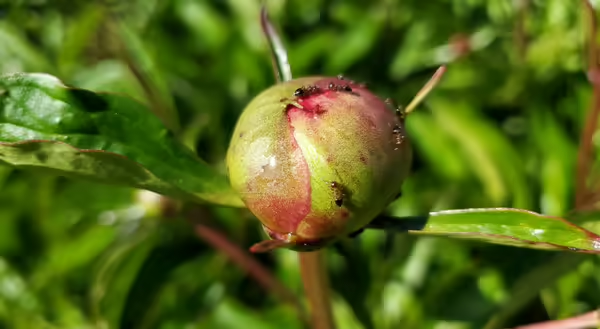
In the plant world, insects can be considered either friend or foe based on their status as beneficial partners or pests. We often think of pollinators as the primary friends plants have in the insect world, but there are certainly other beneficial insects that don’t necessarily pollinate flowers.
A common question I often receive this time of year relates to one of these confusing friend or foe type relationships between peonies (Paeonia spp.) and ants.
Most peony varieties are approaching their peak bloom time. Although some early bloomers may be sporting fully developed flowers already, most peonies are filled with large round flower buds that will continue to swell in coming days until bursting into the massive layered flowers that make these plants so popular as ornamentals.
Upon closer inspection of the spherical flower buds, gardeners are often alarmed to see ants roaming about. Given the ant’s reputation in other contexts, such as on your kitchen counter, we often think of them as enemies. When they cover peony buds, many gardeners consider taking action to control the swarming ants in fear they may negatively impact flower development. However, the truth is that these tiny insects are providing a benefit to the plant while gaining some valuable food for their colony.
Are Ants Beneficial?
If you read opinions about ants on peony flowers, there is a whole range of thoughts on the subject which tends to promote many of the common myths associated with this relationship. Some correctly identify the relationship as positive, but misidentify the benefit, claiming that ants are required for proper flower development. Claims range from “ants tickle the buds until they open” or “pry” flower buds open to others noting some magical ingredient that ants spread on the buds to induce flowering.
It is true that ants leave a pheromone trail so others can find the same food resources. Once the first scout discovers the sticky food surrounding the developing flower bud, it marks the location so others may follow. However, these pheromones have not been shown to have any effect on peony flower development.
In the most negative view of the ants present on peonies, some incorrectly recommend control, either from pesticides or cultural methods. I think this recommendation stems from the negative view of ants in the home or other human-dominated locations. We typically don’t like ants in our space and it is an excellent recommendation to control ants in your home. However, in the garden ants may have a different role entirely and on peony flowers, its pays to let them be.
As I implied above, the main attractant for ants is food. If you take a close look at a peony bud you’ll notice a shiny, sticky substance on the outside of the bud, which is nectar, the same attractant that flowers use to draw in pollinators.
Nectar-producing flowers secrete this sweet substance from nectar glands, called nectaries, that are often strategically placed in the flower structure to ensure contact with pollen as feeding insects converge on this food source. Peonies actually have nectaries on their sepals, which are the green, leaf-like structures that cover the flower bud. As buds swell and get larger, the green sepals become coated in nectar, which draws in ants and other interested insects.
The benefit to the peony is that ants readily defend their food source and will actively remove other insects. While ants harvest the nectar present, other insects may cause damage as they feed. By running off these “pests” the ants help preserve flowers parts from damage.
For humans, these ants still pose a problem if you intend to use peonies as cut flowers. The ants will hang around on flowers after they develop fully and tend to wander off from that flower bouquet in the middle of the dining room table. However, there are few simple tricks to remove the ants at harvest time.
Peony flowers can be harvested in the “marshmallow stage”, the point at which flower buds go from being hard and tight to squishy like a marshmallow. It is easy to dip marshmallow stage flower buds in water and simply wash off any ants. Within days these buds will open and fully develop.
If peony flowers are fully opened, they can be held upside down at harvest and gently shaken to knock off most of the ants. If some persist, they can be washed away by dipping the flower into water (upside down) and gently swirling until the ants are removed.